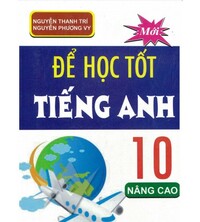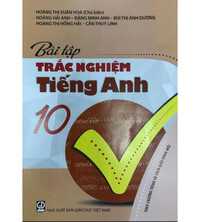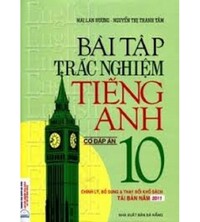Tiếng Anh 10 Unit 7 Speaking
1. Complete the conversation about a UNICEF programme with the sentences in the box. Then practise it in pairs. 2. Work in pairs. Student A looks at the table below. Student B looks at the table on page 85. Ask each other the questions in 1 to complete your table. 3. Work in groups. Discuss and decide which programme or project in 1 and 2 will bring more benefits to people in your local area. Then share your ideas with the whole class.
Bài 1
Programmes for communities
1. Complete the conversation about a UNICEF programme with the sentences in the box. Then practise it in pairs.
(Hoàn thành bài hội thoại về chương trình UNICEF bằng các câu trong khung. Sau đó thực hành theo cặp.)
|
a. It offers young people job training and career advice. It also teaches them essential skills for the job market. |
|
b. It is Education for Disadvantaged Young People. |
|
c. It focuses on helping disadvantaged teenagers continue their education. |
A: What is the name of the programme?
B: (1) ________________________
A: What does the program focus on?
B: (2) ________________________
A: What are the activities of this programme?
B: (3) ________________________
Phương pháp giải:
It offers young people job training and career advice. It also teaches them essential skills for the job market.
(Nó cung cấp đào tạo việc làm và lời khuyên nghề nghiệp cho những người trẻ tuổi. Nó cũng dạy họ những kỹ năng cần thiết cho thị trường việc làm.)
It is Education for Disadvantaged Young People.
(Đó là Giáo dục cho Thanh thiếu niên có hoàn cảnh khó khăn.)
It focuses on helping disadvantaged teenagers continue their education.
(Nó tập trung vào việc giúp đỡ những thanh thiếu niên có hoàn cảnh khó khăn tiếp tục đi học.)
Lời giải chi tiết:
A: What is the name of the programme?
(Tên của chương trình là gì)
B: (1) It is Education for Disadvantaged Young People.
(Đó là Giáo dục cho Thanh thiếu niên có hoàn cảnh khó khăn.)
A: What does the program focus on?
(Chương trình tập trung vào cái gì?)
B: (2) It focuses on helping disadvantaged teenagers continue their education.
(Nó tập trung vào việc giúp đỡ những thanh thiếu niên có hoàn cảnh khó khăn tiếp tục đi học.)
A: What are the activities of this programme?
(Các hoạt động của chương trình này là gì?)
B: (3) It offers young people job training and career advice. It also teaches them essential skills for the job market.
(Nó cung cấp đào tạo việc làm và lời khuyên nghề nghiệp cho những người trẻ tuổi. Nó cũng dạy họ những kỹ năng cần thiết cho thị trường việc làm.)
Bài 2
2. Work in pairs. Student A looks at the table below. Student B looks at the table on page 85. Ask each other the questions in 1 to complete your table.
(Làm việc theo cặp. Học sinh A nhìn vào bảng dưới đây. Học sinh B nhìn vào bảng ở trang 85. Hỏi nhau các câu hỏi trong bài 1 để hoàn thành bảng của bạn.)
|
UNICEF Programme |
UNDP Project |
|
|
What / name? |
Vaccines for Children |
____________________ |
|
What / focus on? |
protecting children with life-saving vaccines |
____________________ |
|
What / activities? |
- educating people about the benefits of vaccines - vaccinating as many children as possible |
____________________ |
Example:
A: What is the name of the UNDP Project?
B: It’s …
Lời giải chi tiết:
|
UNICEF Programme |
UNDP Project |
|
|
What / name? |
Vaccines for Children (Vắc xin cho Trẻ em.) |
Poverty Reduction (Giảm nghèo) |
|
What / focus on? |
protecting children with life-saving vaccines (bảo vệ trẻ em bằng vắc-xin cứu mạng) |
reducing poverty and developing economy in disadvantaged areas (xóa đói giảm nghèo và phát triển kinh tế ở những vùng khó khăn) |
|
What / activities? |
- educating people about the benefits of vaccines (giáo dục bảo vệ trẻ em bằng vắc-xin cứu mạng) - vaccinating as many children as possible (tiêm chủng cho càng nhiều trẻ em càng tốt) |
- providing technical support (cung cấp hỗ trợ kỹ thuật) - helping develop solutions to local issues (giúp phát triển các giải pháp cho các vấn đề địa phương) |
A: What is the name of the UNDP Project?
(Tên của dự án UNDP là gì)
B: It’s Poverty Reduction.
(Đó là Giảm nghèo.)
A: What does the project focus on?
(Dự án tập trung vào cái gì?)
B: It focuses on reducing poverty and developing economy in disadvantaged areas.
(Nó tập trung vào việc xóa đói giảm nghèo và phát triển kinh tế ở những vùng khó khăn.)
A: What are the activities of this project?
(Các hoạt động của dự án này là gì?)
B: It provides technical support and helps develop solutions to local issues. What about UNICEF Programme? What is the name of the programme?
(Nó cung cấp hỗ trợ kỹ thuật và giúp phát triển các giải pháp cho các vấn đề địa phương. Chương trình UNICEF thì sao? Tên của chương trình là gì?)
A: It’s Vaccines for Children.
(Đó là Vắc xin cho Trẻ em.)
B: What does the program focus on?
(Chương trình tập trung vào cái gì?)
A: It focuses on protecting children with life-saving vaccines.
(Nó tập trung vào việc bảo vệ trẻ em bằng vắc-xin cứu mạng.)
B: What are the activities of this programme?
(Các hoạt động của chương trình này là gì?)
A: It educates protecting children with life-saving vaccines and vaccinates as many children as possible.
(Nó giáo dục bảo vệ trẻ em bằng vắc-xin cứu mạng và tiêm chủng cho càng nhiều trẻ em càng tốt.)
Bài 3
3. Work in groups. Discuss and decide which programme or project in 1 and 2 will bring more benefits to people in your local area. Then share your ideas with the whole class.
(Làm việc theo nhóm ba. Thảo luận và quyết định chương trình hoặc dự án nào trong bài 1 và bài 2 sẽ mang lại nhiều lợi ích hơn cho người dân trong khu vực địa phương của bạn. Sau đó chia sẻ ý kiến của bạn với cả lớp.)
|
Useful expressions: I think/ believe that the project/ programme … is more important/ necessary for my local area because … This project/ programme helps local people … / brings local people more opportunities to … In our groups, most of us agree that … But one member thinks that … |
Example:
A: Now, let’s decide which programme or project will bring more benefits to people in our village. B, what do you think?
(Bây giờ, hãy quyết định xem chương trình hoặc dự án nào sẽ mang lại nhiều lợi ích hơn cho người dân trong làng của chúng ta. B, bạn nghĩ gì?)
B: Well, I think Education for Disadvantaged Young People will be a very useful programme for our village. You see, many teenagers here drop out of school and start working to earn a living. They really need help.
(Ồ, tôi nghĩ Giáo dục cho Thanh thiếu niên Có hoàn cảnh khó khăn sẽ là một chương trình rất hữu ích cho ngôi làng của chúng ta. Bạn thấy đấy, nhiều thanh thiếu niên ở đây đã bỏ học và bắt đầu làm việc để kiếm sống. Họ thực sự cần giúp đỡ.)
A: You’re right, B.
(Bạn nói đúng, B.)
Phương pháp giải:
A: Now, let’s decide which programme or project will bring more benefits to people in our village. B, what do you think?
(Bây giờ, hãy quyết định xem chương trình hoặc dự án nào sẽ mang lại nhiều lợi ích hơn cho người dân trong làng của chúng ta. B, bạn nghĩ gì?)
B: Well, I think Vaccines for Children will be a very useful programme for our village. You see, each family in our area has at least 2 children and not all parents are educated about the benefits of vaccines. They really need help.
(Chà, tôi nghĩ Vắc xin cho Trẻ em sẽ là một chương trình rất hữu ích cho thôn của chúng ta. Bạn thấy đấy, mỗi gia đình trong khu vực của chúng ta có ít nhất 2 trẻ em và không phải tất cả các bậc cha mẹ đều được giáo dục về lợi ích của vắc xin. Họ thực sự cần giúp đỡ.)
A: You’re right, B.
(Bạn nói đúng, B.)
Search google: "từ khóa + timdapan.com" Ví dụ: "Tiếng Anh 10 Unit 7 Speaking timdapan.com"







